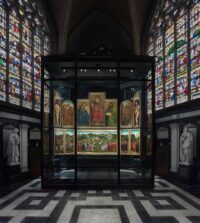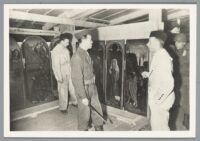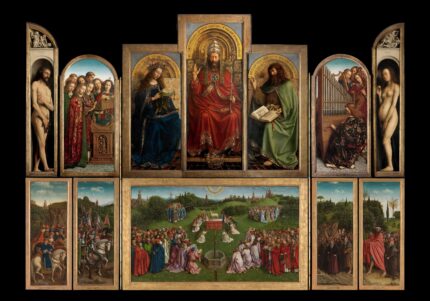 Almost a decade after a comprehensive multidisciplinary program of conservation and restoration began, the Adoration of the Mystic Lamb, also known as the Ghent Altarpiece, has gone back on display at Saint Bavo’s Cathedral in Ghent in a new high-tech setting.
Almost a decade after a comprehensive multidisciplinary program of conservation and restoration began, the Adoration of the Mystic Lamb, also known as the Ghent Altarpiece, has gone back on display at Saint Bavo’s Cathedral in Ghent in a new high-tech setting.
The double-sided 12-panel polyptych by Hubert and Jan van Eyck has been relocated from a small chapel near the entrance to the Sacrament chapel, one of the largest chapels in the cathedral and close to the location where the altarpiece was first installed. The space was enlarged to make way for a new bespoke display case and to aid in the flow of traffic when visitors can once again flock to see the Northern Renaissance’s greatest masterpiece.
The custom case cost more than $35 million. It is bulletproof, climate controlled and contains pneumatically controlled steel supports that allow the wings of the panels to be opened every morning and closed every evening so at different times visitors can see both the vividly colored front of the panels and the muted tones and grisailles on the reverse.
Experts from the Royal Institute for Cultural Heritage (KIK-IRPA, Brussels) discovered a great deal about the iconic masterpiece, removing centuries of discolored varnish, retouches and overpaint to reveal the original work by the van Eycks. From 2012 until its completion at the end of 2019, the program’s archival research, radiography, multispectral imaging and ground-breaking technical study cast new light on Van Eyck’s original vision for the polyptych. The Mystic Lamb, central figure of the composition, got a completely new face, or rather got his first, much more human-like face back.
 The research, documentation and imaging data were integrated into a truly best-in-class website with high-resolution photographs of the Ghent Altarpiece. The website has been active for years, sharing the results of this seminal study of the altarpiece in granular, brushstroke-level detail. Most recently, the complete oeuvre of Jan van Eyck, his studio and followers has been added to the site, so its purview goes far beyond the altarpiece alone.
The research, documentation and imaging data were integrated into a truly best-in-class website with high-resolution photographs of the Ghent Altarpiece. The website has been active for years, sharing the results of this seminal study of the altarpiece in granular, brushstroke-level detail. Most recently, the complete oeuvre of Jan van Eyck, his studio and followers has been added to the site, so its purview goes far beyond the altarpiece alone.
Visitors to Saint Bavo’s will first be directed to the crypt where art works and objects related to the altarpiece and the Van Eycks, including the grave of Hubert van Eyck, are exhibited. The experience is enhanced by Microsoft HoloLens, which unlike VR helmets allows users to see the space as it is while adding a digital layer of augmented reality. The headset tours will illuminate the history of the altarpiece, how it was created, the meaning of its dense allegories and portraits.
For now, pandemic measures restrict the number of visitors allowed into the crypt and the chapel — 350 tickets a day for the former, five people at a time for the latter.
